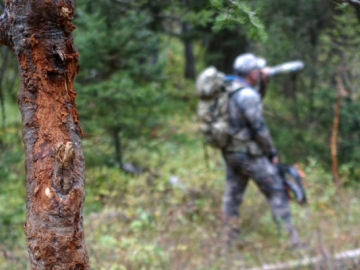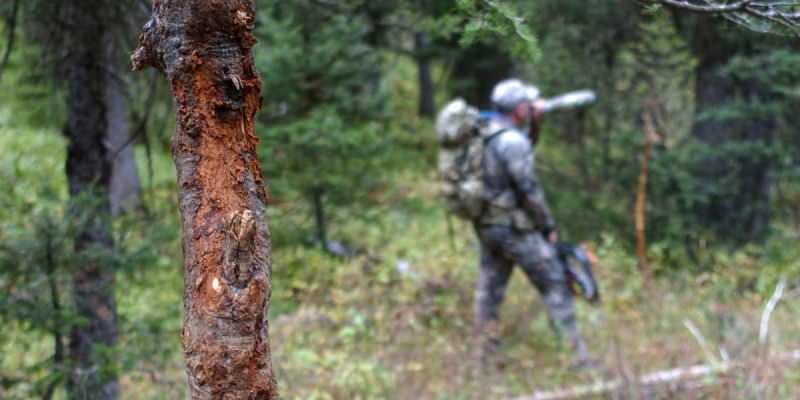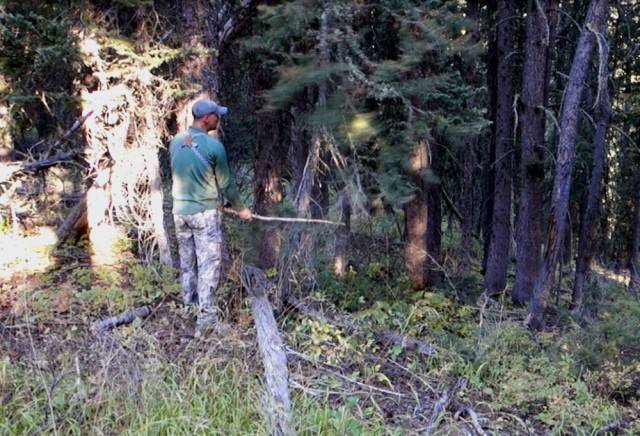Raking Trees for Elk


Back in the late 1990’s, I was able to spend several days filming elk during the rut in an area that had restricted hunting pressure. The elk populations were insane, and the absence of hunting made for a perfect recipe for elk overload. With video camera in hand, I headed out the first morning, dreaming of call-in after call-in and envisioning the up-close bugling footage I was going to be able to film.
The vocalizations from both bulls and cows was non-stop and quite intense, and by around 10:00 a.m., I had two tapes full of great audio. However, I had yet to call in a single bull. I sat down on a ridge overlooking a large meadow and took a break while observing the action. Elk were screaming in every corner of the meadow, and after watching this for several minutes, I couldn’t take it any longer. I grabbed my bugle tube and threw a bugle of my own into the meadow. The elk went silent for several minutes before slowly picking back up where they had left off. Twice more I tried to call and was met with the same results. These were elk that had not been called to by hunters at all, and didn’t know any kind of hunting pressure. I began to piece together a phenomenon I had witnessed – but never visualized – many times in the past.
When there is a higher density of elk, particularly when there are plenty of cows and lots of bulls, it can be difficult to call bulls away from their harems. I was seeing this unfold first-hand, and I was not happy about it. Unfortunately, I didn’t know what to do to get them in close.
As I was watching the chaos, I noticed a bull leave his herd and head in my general direction. I was optimistically thinking he was coming to my calls, but he stopped just 80 yards away from his cows and began tearing up a decent-sized pine tree with his antlers. Immediately, another bull on the opposite side of the meadow left his herd and ran toward the raking bull, screaming a high-pitched, aggressive bugle. The bulls faced off, and while they didn’t actually engage in combat, they postured and screamed threats at each other for the better part of five minutes. I rolled the video camera, and as soon as they separated and went back to their herds, I put this new tactic to the test.
 I had mimicked the raking of a tree many times in the past, but it had always been in conjunction with calling, and was usually just me copying what the bull was doing as I called to him. This time, I set my bugle tube on the ground, and within a matter of minutes, I had three bulls inside 100 yards looking for the source of the raking. For the next two days, I called in multiple bulls simply by raking trees. I also witnessed a handful of fights between bulls, most of which started with one of the bulls raking a tree.
I had mimicked the raking of a tree many times in the past, but it had always been in conjunction with calling, and was usually just me copying what the bull was doing as I called to him. This time, I set my bugle tube on the ground, and within a matter of minutes, I had three bulls inside 100 yards looking for the source of the raking. For the next two days, I called in multiple bulls simply by raking trees. I also witnessed a handful of fights between bulls, most of which started with one of the bulls raking a tree.
Bulls “rub” trees in mid-to-late August as a way of removing the velvet from their antlers and strengthening their necks for the battles that will ensue over the coming weeks. But they also use their antlers to “rake” trees during the rut as a sign of dominance. It is this display of dominance that I have found to be quite effective at bringing rutting bulls into close quarters in September.
Early in the season, or in areas where bulls are getting a lot of calling pressure, raking can be used effectively as a stand-alone method for bringing bulls in close. Most often, I prefer to add raking to my calling sequences, and it is often the raking that seals the deal and brings a stubborn herd bull away from his cows. The challenges and insults from the calls are hard to ignore, but when his dominance is questioned by a challenger raking a tree, it is often too much.
Raking a tree is simple, and takes no mechanical or commercially developed gear to replicate. Simply find a decent sized stick, then start thrashing a small sapling or bush with it. Elk can get pretty intense when they start tearing up a tree with their antlers, so put that same intensity into your raking. Stomp the ground, break branches, and make some noise. I like to really dig the raking stick into the trunk of the tree in addition to thrashing the limbs on the tree.
Similar to calling, the closer you can get to the bull to begin raking, the better off you will be. A display of dominance at a close distance will have a much more powerful effect than it does from far away.
While raking doesn’t work 100% of the time, it is another useful and effective tactic to carry in your quiver of strategies, and it is one I rely on almost as much as calling to bring big bulls into bow range.

